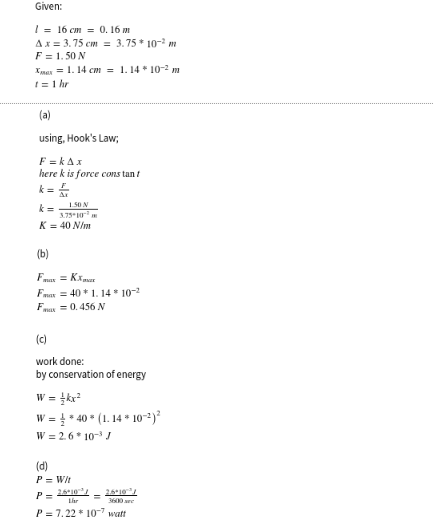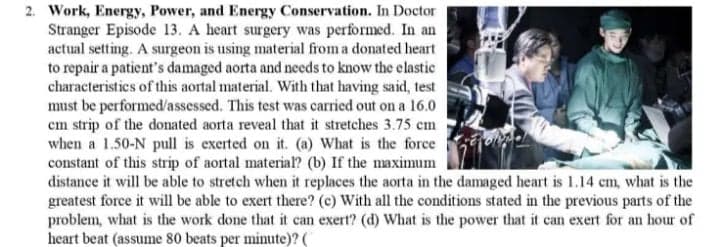Work, Energy, Power, and Energy Conservation. In Doctor Stranger Episode 13. A heart surgery was performed. In an actual setting. A surgeon is using material from a donated heart to repair a patient's damaged aorta and needs to know the elastic characteristics of this aortal material. With that having said, test must be performed/assessed. This test was carried out on a 16.0 em strip of the donated aorta reveal that it stretches 3.75 cm when a 1.50-N pull is exerted on it. (a) What is the force constant of this strip of aortal material? (b) If the maximum distance it will be able to stretch when it replaces the aorta in the damaged heart is 1.14 cm, what is the greatest force it will be able to exert there? (c) With all the conditions stated in the previous parts of the problem, what is the work done that it can exert? (d) What is the power that it can exert for an hour of heart beat (assume 80 beats per minute)? (
Work, Energy, Power, and Energy Conservation. In Doctor Stranger Episode 13. A heart surgery was performed. In an actual setting. A surgeon is using material from a donated heart to repair a patient's damaged aorta and needs to know the elastic characteristics of this aortal material. With that having said, test must be performed/assessed. This test was carried out on a 16.0 em strip of the donated aorta reveal that it stretches 3.75 cm when a 1.50-N pull is exerted on it. (a) What is the force constant of this strip of aortal material? (b) If the maximum distance it will be able to stretch when it replaces the aorta in the damaged heart is 1.14 cm, what is the greatest force it will be able to exert there? (c) With all the conditions stated in the previous parts of the problem, what is the work done that it can exert? (d) What is the power that it can exert for an hour of heart beat (assume 80 beats per minute)? (
College Physics
1st Edition
ISBN:9781938168000
Author:Paul Peter Urone, Roger Hinrichs
Publisher:Paul Peter Urone, Roger Hinrichs
Chapter7: Work, Energy, And Energy Resources
Section: Chapter Questions
Problem 13CQ: Consider the following scenario. A car for which friction is not negligible accelerates from rest...
Related questions
Topic Video
Question
2. Can you please THOROUGHLY explain how did you solve this? I need it in step by step format because I'm going to explain it in class. Please help me, thank you

Transcribed Image Text:Given:
1 = 16 cm = 0. 16 m
Ax = 3.75 cm = 3.75* 10- m
F = 1. 50 N
Xman = 1. 14 cm = 1. 14 * 10-2 m
I=1 hr
(a)
using, Hook's Law;
F = kAx
here k is force cons tan t
k =
1.50 N
3.75 10
K = 40 N/m
(b)
Fmar = Kxmar
Fmar = 40 * 1. 14 * 10-2
Fa = 0. 456 N
(c)
work done:
by conservation of energy
W =
W = * 40 * (1. 14 * 10~²)²
W = 2.6 * 10- J
(d)
P = Wit
2,6°10/
2,6*10
Lhr
P = 7.22 * 10-7 watt

Transcribed Image Text:2. Work, Energy, Power, and Energy Conservation. In Doctor
Stranger Episode 13. A heart surgery was performed. In an
actual setting. A surgeon is using material from a donated heart
to repair a patient's damaged aorta and needs to know the elastic
characteristics of this aortal material. With that having said, test
must be performed/assessed. This test was carried out on a 16.0
cm strip of the donated aorta reveal that it stretches 3.75 em
when a 1.50-N pull is exerted on it. (a) What is the force
constant of this strip of aortal material? (b) If the maximum
distance it will be able to stretch when it replaces the aorta in the damaged heart is 1.14 cm, what is the
greatest force it will be able to exert there? (c) With all the conditions stated in the previous parts of the
problem, what is the work done that it can exert? (d) What is the power that it can exert for an hour of
heart beat (assume 80 beats per minute)? (
Expert Solution
This question has been solved!
Explore an expertly crafted, step-by-step solution for a thorough understanding of key concepts.
Step by step
Solved in 2 steps with 3 images

Knowledge Booster
Learn more about
Need a deep-dive on the concept behind this application? Look no further. Learn more about this topic, physics and related others by exploring similar questions and additional content below.Recommended textbooks for you

College Physics
Physics
ISBN:
9781938168000
Author:
Paul Peter Urone, Roger Hinrichs
Publisher:
OpenStax College

College Physics
Physics
ISBN:
9781305952300
Author:
Raymond A. Serway, Chris Vuille
Publisher:
Cengage Learning

Principles of Physics: A Calculus-Based Text
Physics
ISBN:
9781133104261
Author:
Raymond A. Serway, John W. Jewett
Publisher:
Cengage Learning

College Physics
Physics
ISBN:
9781938168000
Author:
Paul Peter Urone, Roger Hinrichs
Publisher:
OpenStax College

College Physics
Physics
ISBN:
9781305952300
Author:
Raymond A. Serway, Chris Vuille
Publisher:
Cengage Learning

Principles of Physics: A Calculus-Based Text
Physics
ISBN:
9781133104261
Author:
Raymond A. Serway, John W. Jewett
Publisher:
Cengage Learning

Physics for Scientists and Engineers with Modern …
Physics
ISBN:
9781337553292
Author:
Raymond A. Serway, John W. Jewett
Publisher:
Cengage Learning


College Physics
Physics
ISBN:
9781285737027
Author:
Raymond A. Serway, Chris Vuille
Publisher:
Cengage Learning